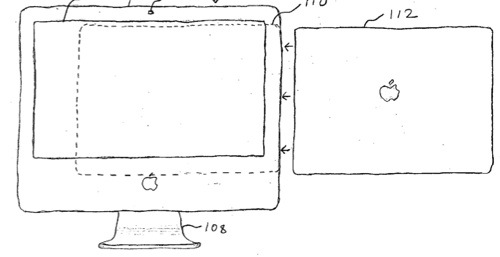An Apple patent (number 7,684,185) that first appeared in 2006 has re-appeared at the U.S. Patent & Trademark Office. It’s for an integrated monitor and docking station. And you have to wonder if it hints at a future iteration of the iPad.
After all, the patent is for a portable computer — and said portable computer doesn’t appear to be an iPod or anything currently available. The docking station includes a display and a housing configured to hold the display in a manner that exposes a viewing surface of the display to view. The housing defines a docking area configured to receive a portable computer. The docking area is at least partly obscured by the display when viewed from the viewing surface side of the display at an angle substantially orthogonal to the viewing surface.
Traditionally a portable computer docking station requires a separate external monitor to be connected (e.g., by cable) to the docking station when a display other than the integrated display of the portable computer is desired to be used with the docking station, Apple notes. Often a significant amount of desk space is required for placement of this docking station and separate display. Attempts have been made to conserve the required amount of desk space by allowing the external display to be stacked on top of the docking station. However, the stacked combination still occupies a large amount of space and is cumbersome to move and transport. Therefore there exists a need for a docking station and display combination that is configured in a more efficient form.
The invention can be implemented in numerous ways, including as a process, an apparatus, a system, a composition of matter, a computer readable medium such as a computer readable storage medium or a computer network wherein program instructions are sent over optical or electronic communication links. In this specification, these implementations, or any other form that the invention may take, may be referred to as techniques. A component such as a processor or a memory described as being configured to perform a task includes both a general component that is temporarily configured to perform the task at a given time or a specific component that is manufactured to perform the task. In general, the order of the steps of disclosed processes may be altered within the scope of the invention.
The inventor is Augustin Farrugia. The graphic shows a front view of the docking station.


